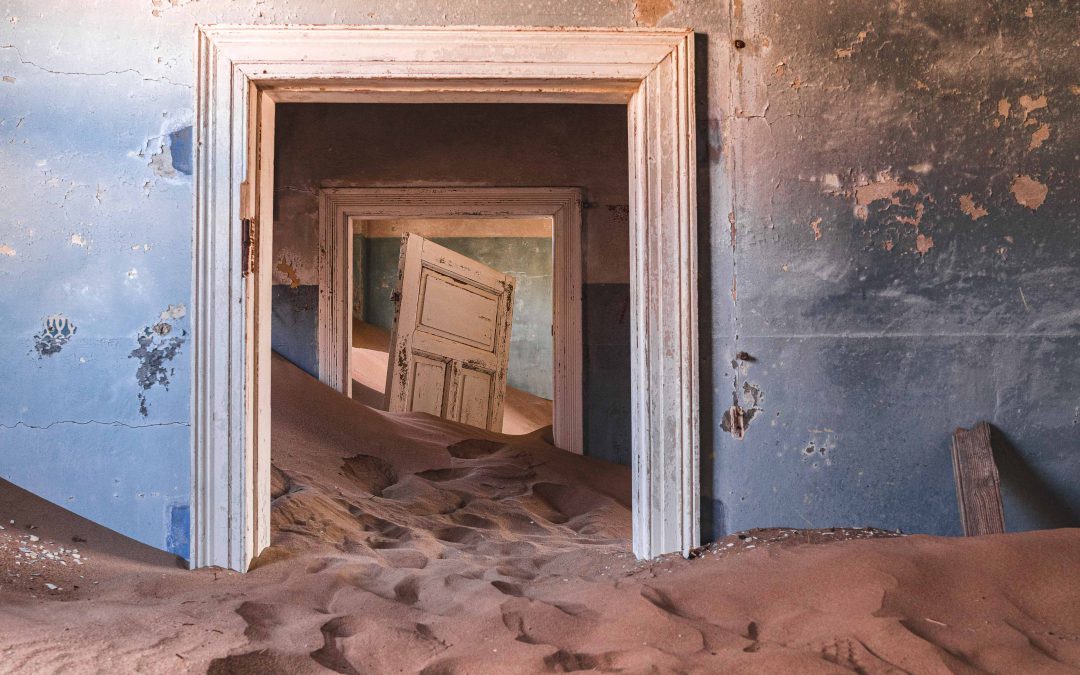Have you ever seen those images of a ghost town buried in sand scrolling through your Instagram feed and wondered…
where in the world is that?
It’s not too surprising this peculiar destination, the ghost town of Kolmanskop is found in none other than Namibia.
The images people have captured here are enough to ignite your imagination – at least they do for me. If somehow you’ve managed to miss seeing these pictures, try to visualize a battered and abandoned mining town with dilapidated buildings scattered all about. With that visual in mind, add thousands of dump trucks of sand inside and around all the structures. Imagine sand drifts halfway up doorways obstructing the opening and forcing you to crouch almost crawling to get through. Imagine stairways with steps disappearing into the sand, even a lone bathtub sitting solitarily in the open on a bed of sand. The whole town, surrounded by dunes, ominously inching closer and closer, eventually to swallow all that remains of the town.
Where is Namibia’s Ghost Town of Kolmanskop?
Within Namibia, Kolmanskop is found along the Atlantic coastline in the Southern part of the country. Part of the Namib desert, this is a harsh region of the country predominantly covered in sand, sparsely vegetated, and continuously battered by the unrelenting gales off the Atlantic ocean. Luderitz is the nearest populated town at around twenty minutes away. It is here that anyone who visits Kolmanskop will likely stay.

Kolmanskop, Luderitz and the Sperrgebiet
A visit to Kolmanskop is an intentional one. It is somewhat ‘out of the way’ to get to. If you’re on a road trip through the country, it’s not really an area ‘on the way’ to anything else at all. The town of Luderitz is actually the end of the line for highway B4 and all the surrounding area is part of the Sperrgebiet, a German word meaning ‘Prohibited Area.’ This designation and reservation of land was done so after the discovery of diamonds. At one time, the area was solely controlled by the DeBeers company. Today, control of the land is shared between DeBeers and the national government under the entity NamDeb. In all, the Sperrgebiet accounts for three percent of Namibia’s landmass, which equates to an area of roughly 10,000 square miles! As the translation suggests, entry into this area is indeed prohibited and is actively patrolled. If you spend enough time in Kolmanskop or Luderitz, you’re bound to hear one of the patrol helicopters passing overhead.
They are very serious about unauthorized persons within the restricted area. If you are planning to spend some time in Namibia, it is highly advisable to know where the restricted areas are and stay clear of them!
The Story Behind Kolmanskop and the Sperrgebiet Region
Around the turn of the century, Germany was busy laying down roots and colony building in what is now Namibia. At that time, the region was known to the world as German South West Africa, Germany’s only colony in Africa. To better connect the colonial towns and improve the transportation of goods, the development of a railroad system was of the utmost importance.
In 1908, during the construction of the rail lines near the town of Luderitz, a worker discovered a brilliant sparkling stone within the sand. He had found a diamond! When the news of the discovery made it’s way back to Germany, the empire quickly declared the whole area ‘Sperrgebiet’ and German mining settlements rapidly developed.
Kolmanskop was one of these diamond mining towns and one of the biggest. It’s close proximity to the port town of Luderitz, direct railway access and abundance of diamonds made it a hub for mining activity.
As a result of the diamond wealth, the residents spared no expense to construct elegant buildings reflecting classic German architectural styles. At the town’s peak, it featured a hospital, power station, school, theatre, ballroom, casino, and sports hall. Kolmanskop even boasted the first x-ray station in the southern hemisphere! The residents of Kolmanskop were living it up!
The boom times for Kolmanskop were short-lived though. After World War II, the town was pretty much in decline. Over time, the once abundant the diamond fields started producing less and less. This forced many of the miners to move on to more mineral-rich areas. As fate would have it, In 1928, the richest diamond deposits ever discovered, up to that time, were found in an area south of Kolmanskop near the border with modern-day South Africa. This discovery inevitably drew most of the town’s miners south with their families. By the mid-1950s, the town was ultimately abandoned and left to the sands of time.
Namibia’s Ghost Town Today
Visitors today are now welcome to explore this ghost town that feels… slightly post-apocalyptic. Although badly battered by blowing sand, the structures charming German architecture still shines through, and when seen from a distance, surrounded by the dunes of the Namid desert, it’s presence is cold and somewhat eerie. Signs alluding to the town’s boom days are apparent throughout, but the absence of people provokes a cautionary reaction as a visitor. It’s hard not to imagine the town as it might have been with an active and numerous population.
Visiting Kolmanskop
Access to Kolmanskop is now monitored and controlled. The town is open to visitors every day from 9:00 AM to 1:00 PM. Around 1:00 PM, visitors will be alerted via announcements on an old PA system that the site will soon be closing, and it is time to vacate the premises. They will come and find you if you try and stay past closing time.
Tickets are required for each visitor and can be purchased onsite in the building that was once the town’s community center. Tickets cost $7 (USD) per person. For those bringing a camera along, and we recommend you do, there is an additional $20 (USD) amateur photographer fee.
The community center is the only building still maintained. Inside is a small museum where visitors can peer into what life in the town was like during the peak of the diamond boom. There is also a cafe which serves lunch, and, of course, a gift shop.
A group tour is included with the purchase of your ticket. You do not have to join the tour to explore the town, though. In fact, we recommend you don’t. It is significantly better to just wander around the ghost town on your own. This way you’ll likely find an opportunity to experience a bit a quiet and stillness in one of the dilapidated buildings.
If you are a professional photographer looking to shoot Kolmanskop, for commercial purposes, this will require a permit. The permit grants access to the town outside the general visiting hours. These permits are expensive, however, and if this is something you are interested in, you should apply in advance.
Ideally, the best way to plan your visit is to be there when they open. As the afternoon approaches, so too will the often devastating heat and gale-force afternoon winds. The earlier, the better. Be sure to bring plenty of water with you on your visit. The town is somewhat spread out, and you will end up doing quite a bit of walking through the sand.
Namibia’s peak travel season begins in May and goes through October.
These months comprise Namibia’s dry season and coincide with winter in the southern hemisphere. During this time, there is a limited chance of rain, and unless you venture to the foggy coast, you can expect almost uninterrupted sunshine. Temperatures are moderate in the daytime, but the evenings and early mornings do get very cold.
This season is prime time for viewing the wildlife. In the dry season, grasses and vegetation be receding (drying out), making it much easier to spot animals in the open. Additionally, many of the open water sources will be drying up as well, giving the wildlife no other option but to congregate together at the more permanent waterholes.

Accommodations in Luderitz
There are many options for places to stay while in Luderitz; Hotels, Bed n’ Breakfast’s, and camping are all available. Here are some places to consider.

Camping in Luderitz
If you’re traveling through Namibia though, chances are you’re prepared for camping. If so, there is an exceptional place where you can pitch your tent. The Shark Island campground is situated at the very tip of a strip of that land juts into the harbor. The campsites are all oceanfront, and each one has an excellent view. On Shark Island, there is also has an old lighthouse still in operation worth checking out. While there, campers beware though it does get WINDY. When afternoon winds come through you’ll need to make sure your campsite is secure or else your belongings are liable to be gone with the wind.
Reserve and pay for your campsite prior to arriving through the Namibia Wildlife Resorts site.
What to drive?
Ideally, a 4×4 vehicle is best, and to get back to some locations, it is necessary. Having a four-wheel drive provides the peace of mind that you’ll be able to get yourself out of a hairy situation if needed.
With that said, you do not need a 4×4. We covered a lot of kilometers in a Ford Fiesta, basically a small compact car. The drive was slow going, though. The whole time, I was dodging rocks in the road and taking it easy over the badly wash boarded segments.
When we got out to the Namid desert areas, though, we did upgrade our vehicle to a 4×4. Without it, we would have never made it through the dunes in certain areas of Sossusvlei. This is true for the coastal areas as well. I strongly urge against entering the dunes without a four-wheel drive.
Ideal Plan For Visiting Kolmanskop and staying in Luderitz
When planning your visit to Kolmanskop, the ideal situation is to stay two nights in Luderitz.
Arrive in Luderitz before sunset and get your lodging sorted out. Spend the next morning visiting Kolmanskop and then return to explore around Luderitz in the afternoon. Have dinner in town appreciate the incredible starry night sky and then head out early in the morning, on to your next destination.
The best place to eat in Luderitz?
Barrels Restaurant : This pub-style eatery has a warm, inviting atmosphere serving up hot fresh food and cold draft beers. It is a local favorite and the kind of place you’re likely to wind up sharing a table with people you’ve just met to get a place to sit. Don’t miss it!

Although Kolmanskop and Luderitz can seem like a detour as you plan, and plot your destinations across Namibia – I encourage you to make the detour. The experience of visiting Kolmanskop is an uncommon one and one you would regret missing. Not to mention, the delightful little town of Luderitz will earn a warm place in your heart.
To learn more about visiting Namibia and check out our Namibia Travel Guide HERE!
Pin it!


















